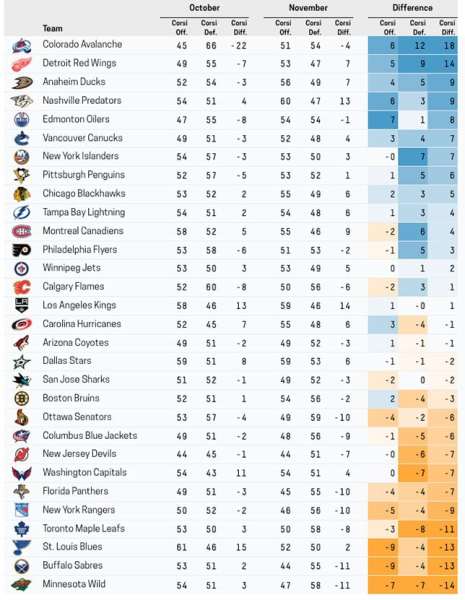
Stats trends show Ducks starting to soar, Wild hitting a skid
Here are three teams that are going in the right direction, and three teams that are trending the other way, based on comparing their performances in October and November.
 Stats trends show Ducks starting to soar, Wild hitting a skid
Stats trends show Ducks starting to soar, Wild hitting a skidWho’s won and who’ll continue to win is an important distinction in the NHL. The leaders of today won’t necessarily be the leaders of tomorrow thanks in part to low-scoring games that make it hard to dictate whose success is legitimate and whose is a mirage. Fewer goals means luck plays a bigger role in a team’s record, for better or worse. That’s why many people have turned to shot rates and possession measures to make sense of the noise. Teams that out-attempt their opponents tend to win more games in the future and that’s been the backbone of the entire analytics movement in hockey.
Shot rates are an important thing to keep an eye on as the season runs along, but it’s especially important to look at which way those shot rates are trending. A team could look great over the full year, but their numbers might be inflated by an unsustainably hot start. Looking at trends in the data can lead to important insights on which way they’re heading for the rest of the season. It might just be a hot or cold stretch they can’t maintain, or a sign of things to come – either way, it’s still worth paying attention to. With that being said, here are three teams that are going in the right direction, and three teams that are trending the other way. All stats are score-adjusted and per 60 minutes via
war-on-ice.com.
Three Up
Colorado: No team has improved on their shot metrics from month to month more than Colorado, which is odd considering they’re the poster child for the anti-numbers crowd. Part of this might be because it’s difficult for a team to be as bad as the Avs were in October and there was simply no place to go but up. The biggest improvement came in their own zone where Colorado went from giving up a league worst 66 shot attempts against in October all the way down to 54 in November. That’s still below average, but it’s a big step in the right direction for a team that looked to be a clone of last year’s Sabres early on. They’re still not a very good team, but they might not be as horrific as they looked to start the season.
Anaheim: The Ducks were a consensus Cup pick by many people before the season started, but looked nothing like a contender out of the gate. The team couldn’t buy a goal and their underlying numbers were sub-par, but they’ve turned it on as of late and that could mean a surge up the standings in the wide-open Pacific. Anaheim was 7-4-3 in November thanks in part to the league’s fifth best Corsi differential during the month. That’s right around the level they were playing at to close last season, which is a great sign for the team. They dug themselves a big hole, but they could easily climb back into the playoff picture if they keep playing like this.
Detroit: The Red Wings were written off by a few people after an underwhelming start to the season, but perhaps that was unwise considering they were without one of the league’s best players and were still learning a new coach’s system. The team was the fourth worst possession team in October – an unfamiliar place for a team built upon the very principle – but have since flipped the script in November by posting the fourth best mark in the league along with the third best shot rate defense. With Pavel Datsyuk back in the fold, and the team better adjusted to the new system, the Wings are back to doing what they do best: controlling the puck.
Three Down
Toronto: A lot of people were quick to cite the “Babcock Effect” after Detroit plummeted down the possession standings and Toronto climbed toward the top, but the tables have turned over the last month. The Leafs had the fourth worst shot rate drop of any team from month-to-month – with most of that coming in their own end – and had the 24th best shot attempt differential in November. That’s back near the level they were at over the past few seasons, so there’s clearly still work to be done by Babcock and co. in fixing the process that’s ailed the team for the past few seasons.
Buffalo: Much like Toronto and Babcock, many were quick to praise Dan Bylsma’s Sabres for a quick turnaround on the shot clock. The Sabres were a historically bad possession team last season, but were above average to start the year. This month, the Sabres found themselves in a more familiar spot: at the bottom of the possession leaderboards. In November, they fired just 44 shot attempts at the net (29th in the league) and gave up 55 (23rd). Like Toronto, the Sabres are learning just how difficult it is to be consistently good in this league, especially when they have a lot more experience being consistently bad.
Minnesota: Here’s a complete list of teams that had a worse Corsi differential in November than the Wild: Sabres, Buffalo. End of list. It wasn’t a great month for the Wild, but that might be because they lost Zach Parise for a large chunk of it. Minnesota had the biggest possession drop-off of any team in the league by getting seven fewer shot attempts for and giving up seven more shot attempts against than they did in October. This seems to happen every season to Minnesota as they start hot with good underlying numbers and then cool down as their possession drops. They earned just 10 points in 11 games in November, tied for second last in the league. Considering how tough the Central division is, that kind of performance won’t cut it. Here’s how the rest of the league fared last month compared to October.


